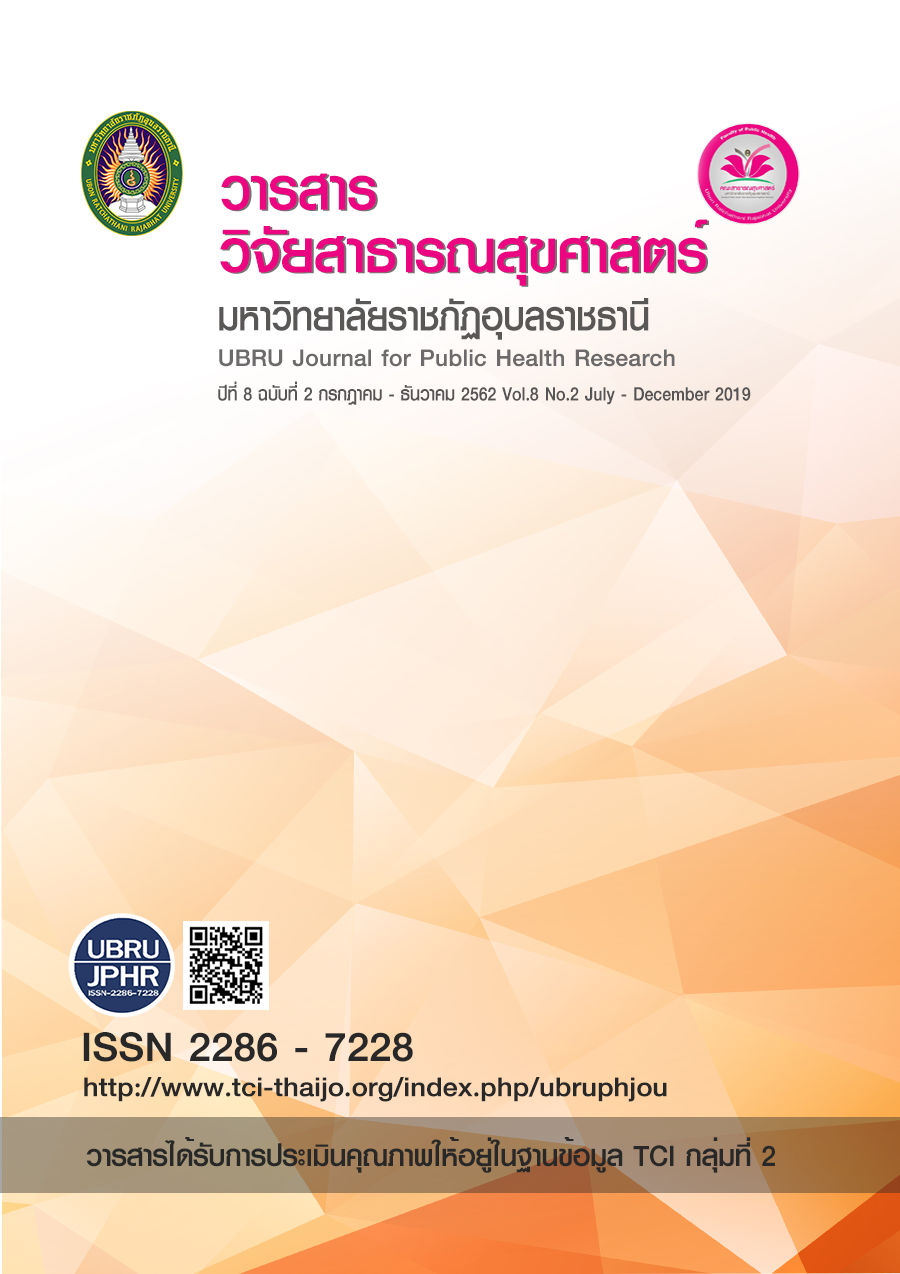Study of medicinal plants utilization in the community of Tambon Kho-ae, Amphoe Khueang Nai, Ubon Ratchathani
Keywords:
Herb, wisdom, communityAbstract
This research aims to explore the medicinal plants and their utilization in the community of Tambon Kho-ae. The survey of medicinal plants was worked together with folk doctors in the community. The study on use of herbs using questionnaires and in-depth interviews with the population of 120 people who have been living in ban Koh, ban Ae, ban Pup, and ban Yang-noi. Most respondents were between 51-60 years old. The dosage forms of herbs used in this study included fresh herbs, decoctions, ointments, inhalants, and medicinal oils, respectively. On the survey of 4 villages, 138 herbs were found. The botanical structures and scientific names were examined, including therapeutic properties obtained the information from users, folk doctors and documental references. The result indicated that the community have taken advantage of the herbs in primary health cares, as the folk doctors helped to guide. Therefore, folk wisdoms of using herbs in the treatment of diseases should be promoted continuously, especially to new generation to know the use of Thai herbs. It is together with the establishment of herbal database as a guide to other people for the information to take care of their own health, and to reduce the burden on medical personnel and government expenditures.
References
สำนักงานนโยบายและแผนสิ่งแวดล้อม. (2561). พื้นที่ชุ่มน้ำที่มีความสำคัญระดับนานาชาติ. [ออนไลน์]. ได้จาก https://wetland.onep.go.th/NongLengsai.html. [สืบค้นเมื่อ 10 มกราคม 2561]
สำนักงานสาธารณสุขจังหวัดพะเยา .(2560). สรุปผลการดำเนินงานประจำปี 2560. พะเยา: สำนักงานสาธารณสุขจังหวัดพะเยา.
Agency for Toxic Substances and Disease Registry (ATSDR). (2007). Toxicological Profile for Lead. [online]. Available from https://www.atsdr.cdc.gov/toxprofiles/tp13.pdf. [cited 20 January, 2017]
Botkin and Keller. (2007). Biomagnifications. [online]. Available from https://dspace.ist.utl.pt/bitstream/2295/50876/1/Saude_riscos_e_toxicologia.pdf. [cited 20 January, 2017]
Codex alimentarius commission. (2006). Joint FAO/WHO Food Standards Programme. Twenty-ninth Session International Conference Centre, Geneva, Switzerland 3 -7 July 2006.
Food Standards Agency. (2007). Front of Pack Nutritional Signpost Labelling Technical Guide Issue. [online]. Available from https://www.food.gov.uk/multimedia/pdfs/frontofpackguidance2.pdf. [cited 20 January, 2017]
Joint FAO/WHO Expert Committee on Food Additives (JECFA) (2000). 55th meeting. Geneva, Switzerland: FAO/WHO, 6-15 June 2000.
Page, N.P. (1994). Human health risk assessment. In Cockerham L, Gandshaned BS(Ed), Basic Environmental Toxicology. Florida: CRC Press, Boca Raton.
U.S. Environmental Protection Agency (2000). Guidance for assessing chemical contaminant data for use in fish advisories, Volume 2-Risk assessment and fish consumption limits 3rded. EPA 823-B-00-008. Washington, D.C., USA
World Health Organization (1992). IPCS Environmental Health Criteria 134. Cadmium. Geneva.
Downloads
Published
How to Cite
Issue
Section
License
เนื้อหาและข้อมูลในบทความที่ลงตีพิมพ์ในวารสารวารสารวิจัยสาธารณสุขศาสตร์ มหาวิทยาลัยราชภัฏอุบลราชธานี ถือเป็นข้อคิดเห็นและความรับผิดชอบของผู้เขียนบทความโดยตรงซึ่งกองบรรณาธิการวารสาร ไม่จำเป็นต้องเห็นด้วย หรือร่วมรับผิดชอบใดๆ
บทความ ข้อมูล เนื้อหา รูปภาพ ฯลฯ ที่ได้รับการตีพิมพ์ในวารสารนี้ ถือเป็นลิขสิทธิ์ของวารสารฯ หากบุคคลหรือหน่วยงานใดต้องการนำทั้งหมดหรือส่วนหนึ่งส่วนใดไปเผยแพร่ต่อหรือเพื่อกระทำการใดๆ จะต้องได้รับอนุญาตเป็นลายลักอักษรณ์จากบรรณาธิการวารสารนี้ก่อนเท่านั้น


